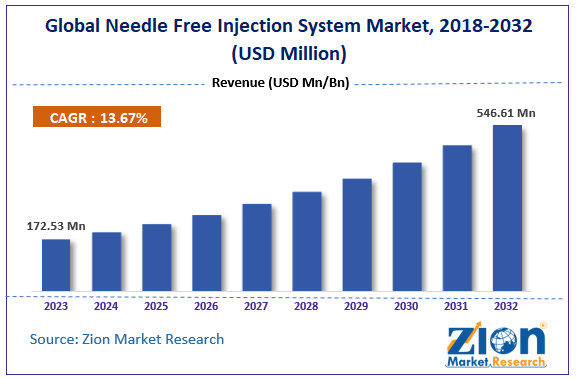Needle Free Injection System Market Size, Share Trends and Forecast 2032
The needle-free injection system market is centered around devices that deliver medications or vaccines without the use of traditional needles. These systems offer a less invasive, pain-free alternative to conventional needle injections, which can help reduce needle-related anxiety and improve patient compliance, especially among children and individuals with needle phobia. The market has gained attention due to its potential applications in mass immunization, chronic disease management, and other therapeutic areas.

Get a Free Sample : https://www.zionmarketresearch.com/sample/needle-free-injection-system-market
Key Market Insights
Market Growth Drivers:
- Rising Prevalence of Chronic Diseases: The increasing incidence of chronic diseases like diabetes, where regular injections are necessary, drives the demand for needle-free injection systems. These devices can improve the quality of life for patients who require frequent injections.
- Need for Improved Patient Compliance: Needle-free systems can reduce the pain and fear associated with needle injections, leading to better adherence to prescribed treatments.
- Technological Advancements: Innovations in needle-free technology, including improved precision, safety features, and ease of use, are driving market growth.
- Growing Demand for Mass Vaccination: Needle-free systems are seen as an effective solution for mass vaccination campaigns, particularly in response to pandemics like COVID-19, where speed and patient comfort are critical.
- Regulatory Approvals and Support: Increased regulatory approvals for needle-free injection systems and growing support for alternatives to traditional needles are bolstering the market.
Market Segmentation:
- By Product Type:
- Jet Injectors: Use a high-pressure stream of fluid to penetrate the skin and deliver medication. These are the most common type of needle-free systems.
- Spring-based Injectors: Utilize a spring mechanism to propel the medication into the skin.
- Laser-powered Injectors: Use laser technology to create a tiny hole in the skin for drug delivery.
- Micro-needle Injectors: Use microneedles to create microscopic channels in the skin, allowing the drug to be absorbed without penetrating deeper tissues.
- By Application:
- Vaccine Delivery: Widely used in vaccination programs due to their ability to quickly and painlessly deliver vaccines to large populations.
- Insulin Delivery: Increasingly used by diabetic patients to avoid the discomfort and inconvenience of daily insulin injections.
- Oncology: Used for delivering cancer treatments, where patient comfort and compliance are critical.
- Pain Management: Employed in delivering pain relief medications, particularly in chronic pain conditions.
- Others: Includes use in hormone therapy, allergy treatments, and dermatological applications.
- By End-User:
- Hospitals and Clinics: The largest segment due to the broad range of applications in patient care.
- Home Care Settings: Growing due to the increasing trend of self-administration of medications, particularly for chronic conditions like diabetes.
- Pharmaceutical and Biotechnology Companies: Utilize needle-free systems for drug delivery in clinical trials and mass production.
- Research Laboratories: Use these systems for preclinical and clinical research, particularly in developing new drug delivery methods.
- By Product Type:
Geographical Insights:
- North America: Dominates the market due to high healthcare expenditure, advanced healthcare infrastructure, and early adoption of new technologies.
- Europe: A significant market driven by growing healthcare awareness, favorable regulatory frameworks, and increasing adoption of needle-free technologies.
- Asia-Pacific: Expected to experience rapid growth due to increasing healthcare investments, a large patient pool, and rising awareness of needle-free options.
- Latin America and Middle East & Africa: Emerging markets with growing healthcare infrastructure and increasing demand for innovative medical technologies.
Challenges:
- High Cost of Devices: Needle-free injection systems can be more expensive than traditional needles and syringes, which may limit adoption, particularly in cost-sensitive regions.
- Technical Limitations: Some needle-free systems may have limitations in terms of dosage accuracy, depth of penetration, and the types of medications that can be delivered.
- Regulatory and Approval Hurdles: The stringent regulatory approval process for new medical devices can delay market entry and increase costs.
- Patient and Healthcare Professional Acceptance: Despite the benefits, there may be resistance to adopting new technologies due to a lack of familiarity or perceived complexity.
Competitive Landscape:
- Key Players: Major companies in the market include PharmaJet, Portal Instruments, Antares Pharma, Bioject Medical Technologies, and Inovio Pharmaceuticals. These companies focus on product innovation, partnerships, and expanding their product offerings.
- Product Innovation: Companies are investing in the development of next-generation needle-free systems that offer improved accuracy, user-friendliness, and broader applications.
Future Trends
- Expansion of Vaccine Delivery Applications: With the ongoing emphasis on global immunization, needle-free systems are likely to see increased use in delivering vaccines, particularly in mass vaccination campaigns.
- Integration with Digital Health: The combination of needle-free systems with digital health tools, such as mobile apps for monitoring and data collection, is expected to enhance patient compliance and outcomes.
- Personalized Medicine: As personalized medicine continues to evolve, needle-free injection systems may play a crucial role in delivering tailored therapies, particularly in oncology and chronic disease management.
- Sustainability and Environmental Impact: The market may see a shift towards more sustainable and eco-friendly needle-free systems, driven by the need to reduce medical waste associated with traditional needles and syringes.
- Increased Focus on Emerging Markets: Companies are likely to target emerging markets with affordable, easy-to-use needle-free systems, addressing the growing demand for innovative healthcare solutions in these regions.
The needle-free injection system market is poised for significant growth as technological advancements, increasing demand for patient-friendly solutions, and the ongoing need for mass vaccination drive the adoption of these systems. The future will likely see continued innovation, broader applications, and greater acceptance of needle-free technology across various therapeutic areas.
Contact :
US OFFICE NO +1 (302) 444-0166
US/CAN TOLL FREE +1 (855) 465-4651
Email: sales@zionmarketresearch.com

Comments
Post a Comment